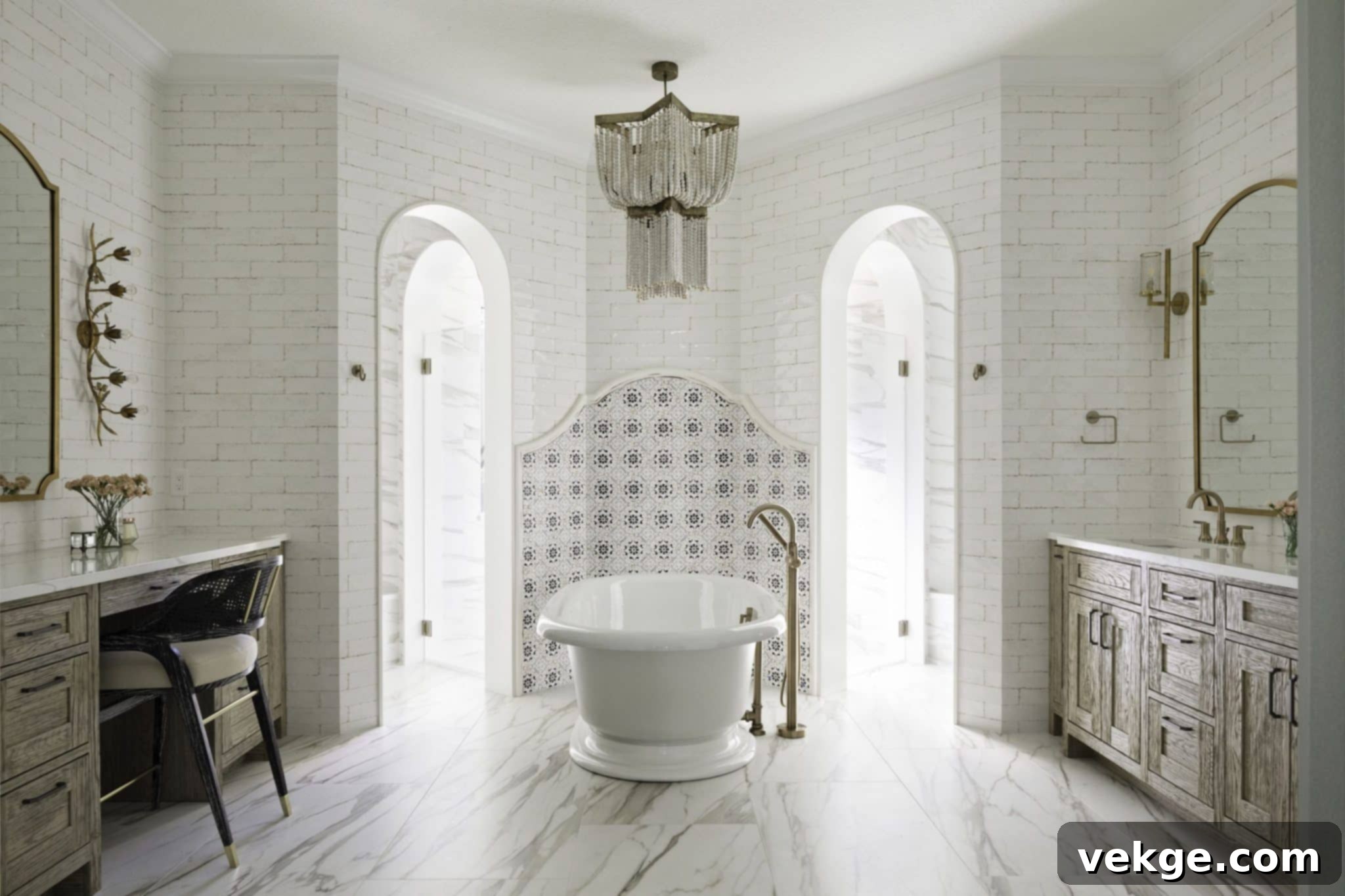Discover the Timeless Charm: Your Guide to French Country Design & Bathroom Style
The allure of French Country design is undeniable, evoking images of sun-drenched Provençal landscapes, ancient stone farmhouses, and interiors that feel both sophisticated and effortlessly lived-in. It’s a style that transcends trends, offering a comfortable elegance that is both inviting and aesthetically pleasing. If you’ve ever dreamt of infusing your home with this unique blend of rustic charm and refined sophistication, you’ve come to the right place. This comprehensive guide will help you unravel the intricacies of French Country style, with a special focus on creating the perfect French Country bathroom.
From its historical roots to its defining characteristics, and the specific elements that bring its magic to life in your living spaces, we’ll explore everything you need to know. Prepare to be inspired as we delve into the world of natural materials, soft color palettes, and the delicate balance between grandeur and simplicity that defines this beloved interior aesthetic.
What Exactly is French Country Style?
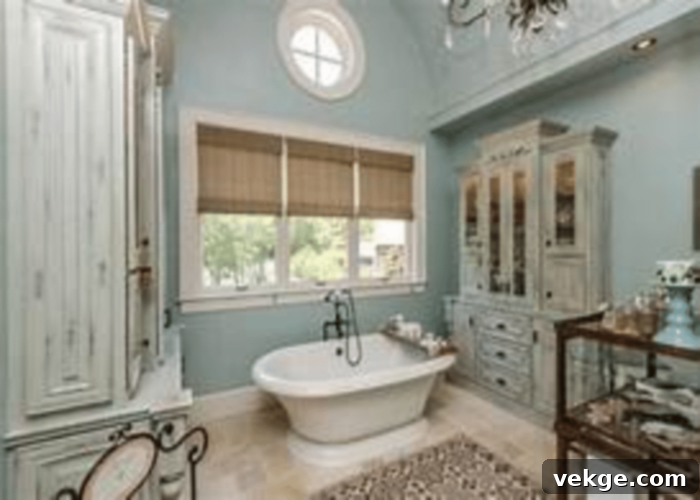
At its heart, French Country style, often interchangeably referred to as French Provincial, is a design philosophy characterized by its simplicity, timeless appeal, and a profound connection to natural building materials. Imagine homes that exude a luxurious yet incredibly comfortable and welcoming atmosphere – that’s the essence of this captivating style. It masterfully blends rustic textures and forms with refined, elegant elements, creating a harmonious balance that feels both grand and grounded.
Unlike more stark or overtly modern aesthetics, French Country design prioritizes warmth, authenticity, and a sense of history. It embraces the beauty of imperfections, celebrating the weathered patinas of wood and stone. Whether applied to an entire home or a specific room like a French country bathroom, this style transforms spaces into functional and aesthetic sanctuaries. Think whitewashed walls, the warmth of exposed wood accents, and an overall natural vibe that promotes relaxation and well-being. Its versatility means it can adapt to various architectural styles, from subtly understated to elegantly ornate, depending on whether the approach leans more traditional or incorporates subtle modern touches.
The Rich Inspiration Behind French Country Style and Bathrooms
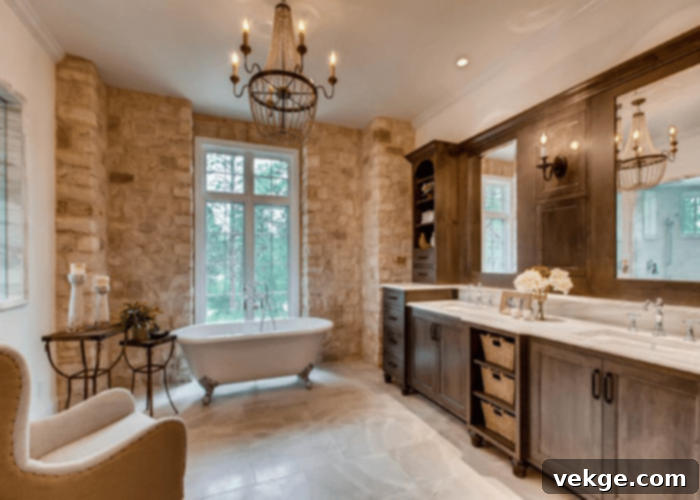
The roots of French Country style are deeply embedded in the picturesque countryside of France, particularly influenced by the grandeur and tastes of the French monarchy. During the 1700s, King Louis XV’s reign saw a surge in rococo elegance and royal luxury. While the aristocracy enjoyed opulent palaces, the gentry and wealthy commoners in the provinces sought to mimic this sophisticated aesthetic, adapting it to their more humble, yet still substantial, homes. This adaptation led to a unique blending of royal luxury with practical, rustic country elements, giving birth to what we now recognize as French Country design. The ornate details were softened, materials became more organic, and the overall feel became more approachable.
This charming style truly gained renewed prominence and refinement in the 1990s, largely thanks to interior designer Charles Faudree. Faudree brilliantly reinterpreted French Country aesthetics, emphasizing an authentic approach that incorporated simple patterns, antique finds, and a comfortable, layered look. His vision propelled the style to new heights of popularity, making it accessible and desirable for a broader audience. Today, the appeal of French Country design extends far beyond its geographical origins, with people worldwide embracing its unique blend of charm and sophistication in their homes and buildings.
A key secret to the enduring beauty of French Country style lies in its celebration of nature. This includes the prominent use of wood and natural stones, often in their raw, weathered, or slightly distressed forms. Whitewash, rather than bold, opaque paints, is frequently preferred for walls and furniture, serving as a protective coating that allows natural textures to show through while brightening the space. This focus on organic elements creates a tranquil, inviting atmosphere that connects inhabitants to the serene beauty of the French countryside.
French Country Bathroom Architecture and Design Elements
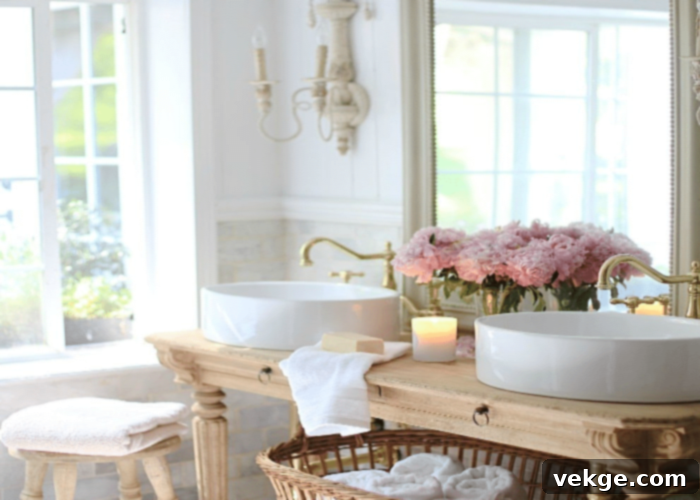
When it comes to the interior architecture of a French Country space, particularly the bathroom, you’ll notice a distinct preference for softer, more delicate lines compared to the sometimes sharper or more industrial feel of modern farmhouse styles. French Country design often leans towards daintier elements and graceful curves rather than stark, angular forms. This translates into specific design choices that create a cohesive and charming aesthetic.
In a French Country bathroom, you’ll frequently find elegant fixtures and furnishings. Sinks are often round, made from materials like ceramic, porcelain, or even hammered copper, sometimes featuring a pedestal design or integrated into a natural wood vanity. Furniture, from vanity stands to storage cabinets, is typically crafted from natural, often distressed, wood, emphasizing craftsmanship and warmth. Beautifully woven storage baskets add both functionality and a rustic touch. Mirrors are not just utilitarian; they are focal points with classic, ornate frames, often gilded or painted in soft, antique finishes that perfectly complement the overall theme. The signature whitewash on the bathroom walls, combined with the rich tones of natural wood, creates a stunning visual contrast that is both bright and inviting.
Decoration and accessories play a vital role in completing the French Country look. Ceiling decoration pieces like ornate chandeliers, often made of wrought iron, crystal, or aged brass, introduce a touch of classic French elegance. Natural metallic accents, particularly brass or aged bronze, are incorporated through handles, tapware, cabinet knobs, and other essential metal items, adding character and a subtle gleam. For those seeking a romantic ambiance, a French Country bathroom can be transformed into a serene retreat. This might include a beautiful clawfoot tub, unique wooden furniture, and elements that promote relaxation, such as lavender-scented candles or diffusers. Candle holders, often antique or vintage-inspired, further enhance the soothing, romantic vibes, making the bathroom a true sanctuary.
Essential Materials for French Country Style

The foundation of French Country style is built upon a curated selection of materials that emphasize authenticity, durability, and a connection to the natural world. Wood and natural stone are undoubtedly the prime focus, often featured in their exposed or subtly distressed forms to showcase their inherent beauty and texture.
Wooden materials are integral, often seen in grand beamed ceilings that add architectural interest and warmth, as well as on floors, where wide plank wood or parquet patterns contribute to the rustic charm. Types of wood like oak, distressed pine, or reclaimed timber are commonly used, favoring finishes that look aged, bleached, or slightly weathered over highly polished surfaces. Natural stones, such as creamy limestone, earthy terracotta, or honed marble, are extensively utilized in fireplaces, flooring, countertops, and even accent walls. The distinctive characteristic here is the preference for a weathered visual appearance rather than a perfectly smooth, factory-finished look. This timeless feature allows the materials to tell a story, reflecting age and character.
Beyond structural elements, the home interior materials for French Country design often include antique commodities that lend a sense of history and heirloom quality. Think of luxurious Bergere chairs covered in elegant silk or linen fabrics, beautifully carved wooden tables, and gilt lamps that cast a soft, inviting glow. Wrought iron, copper, and brass also play significant roles, especially in lighting fixtures, hardware, and decorative accents, adding an artisanal touch. Textiles, such as toile de Jouy, floral patterns, damasks, and checks, in natural fibers like cotton, linen, and wool, further enhance the comfortable and elegant atmosphere, creating a layered and inviting space.
Achieving Balance: Themes and Colors in French Country Interiors
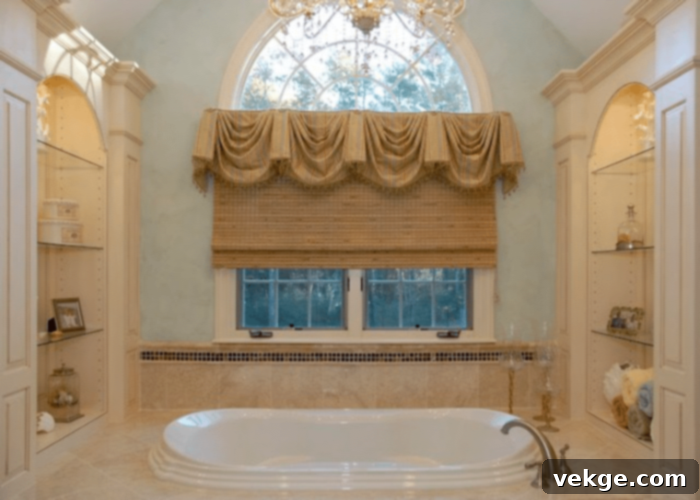
One of the most captivating aspects of French Country style is its exquisite balance between rustic charm and undeniable elegance. This equilibrium is key to creating spaces that feel both refined and incredibly welcoming. In some interpretations, the rustic theme might take center stage, emphasizing rugged textures, exposed elements, and a more informal sensibility. In others, elegance might be the primary theme, expressed through softer lines, more refined finishes, and a touch of subtle grandeur.
Regional variations within France itself historically influenced this balance. For instance, areas closer to Paris often exhibited more refined features, with intricate paneling, ornate moldings, and delicate gilding reflecting aristocratic tastes. Conversely, regions like Provence leaned into a more robust, earthy aesthetic, prioritizing practicality and the raw beauty of their natural surroundings. Modern French Country design seamlessly blends these influences, allowing homeowners to customize the blend. The elegance is often incorporated through wallpapers, sophisticated fabrics, and carefully chosen accents, which are then balanced by the enduring rustic beauty of timeless architectural details and natural materials.
When it comes to color, French Country style relies on a palette of warm, inviting hues with a low to medium intensity, designed to evoke the sun-drenched landscapes of the French countryside. Think of soft, muted tones that feel sun-faded and organic. Common choices include gentle baby blues reminiscent of clear skies, warm pinks inspired by blooming gardens, creamy whites and ivories that brighten spaces, soft yellows mirroring Provencal sunflowers, and a variety of earthy tones like sage green, terracotta, and muted grays. These colors create a serene backdrop for both rustic and elegant elements, fostering a tranquil and harmonious environment.
Fabrics often feature these same muted or slightly richer tones. You’ll find textiles in colors like deep brick red, sunbaked ochre, soft sand, and lavender, often in traditional patterns such as toile, stripes, small checks, or delicate florals. These saturated yet not overly vibrant colors connect the interiors to the natural world, adding depth and visual interest without overwhelming the serene atmosphere that defines French Country living.
Final Thoughts on Embracing French Country Style
The timeless appeal of French Country design continues to captivate homeowners looking to infuse their spaces with a blend of rustic warmth and refined elegance. From its origins in the picturesque French countryside to its modern interpretations, this style offers a truly unique aesthetic that feels both luxurious and approachable. Understanding its core elements – the rich history, distinctive architectural features, emphasis on natural materials, and harmonious color palettes – is the first step towards transforming your home, particularly your bathroom, into a serene and stylish sanctuary.
This guide has aimed to demystify French Country style, providing you with a clear understanding of its fundamental principles and practical insights into how to achieve this coveted look. By embracing weathered woods, natural stones, soft hues, and antique-inspired accents, you can create a home that not only looks beautiful but also feels deeply comforting and inviting.
If you’re eager to discover more innovative ways to enhance your home’s beauty and add lasting value, we invite you to sign up for our newsletter. Get our best design strategies, inspiration, and exclusive tips delivered directly to your inbox, helping you continue your journey toward creating the home of your dreams.
